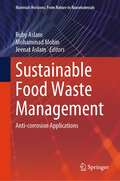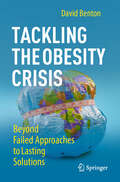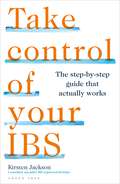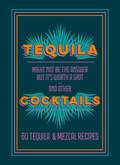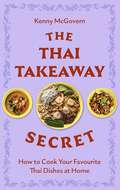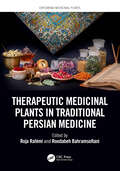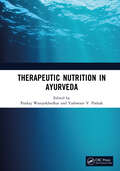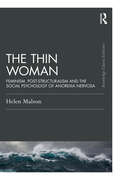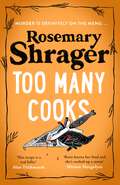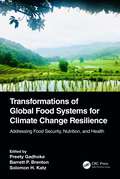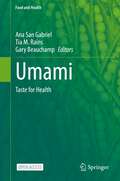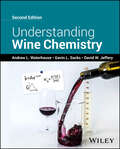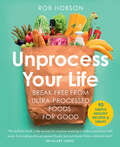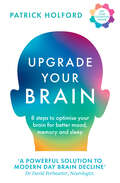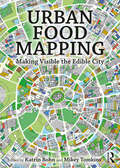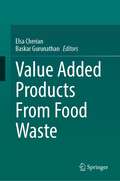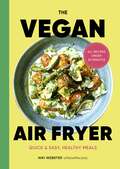- Table View
- List View
Sustainable Food Waste Management: Anti-corrosion Applications (Materials Horizons: From Nature to Nanomaterials)
by Ruby Aslam Mohammad Mobin Jeenat AslamThis book highlights established research and technology on corrosion inhibitors and bio-waste management. It further discusses emerging aspects of utilizing food waste in the field of corrosion inhibition. The topics covered include overview on bio-waste and their management, different types of food waste (i.e., agricultural, vegetable and fruit/fruit juice, plant waste, slaughterhouse trash), and their application as corrosion inhibitors and mitigation of corrosion. It also discusses economic aspects and commercialization of food waste as corrosion inhibitors. The book is a valuable reference for beginners, researchers, and professionals working in the areas of sustainability, food waste management, and material science.
Tackling the Obesity Crisis: Beyond Failed Approaches to Lasting Solutions
by David BentonThe obesity epidemic reflects a failure to understand how meals are chosen. Government initiatives have failed, and most people are unable to control their weight. In this book, an internationally recognized expert on diet and behaviour, discusses the common misunderstandings that have created the epidemic, and suggests how obesity could be reduced.After dieting the body needs fewer calories and you are likely to put on weight. Many people do not understand how to control their weight and rely on ideas that are simply wrong. Natural foods are seen as healthier when they are not. Ultra-processed foods are seen as a problem when the method of production is unimportant. There is little evidence that removing sugar from the diet, banning advertising to children, adding calories to menus, or providing nutritional information on packaging reduces obesity. In fact, removing fat from the diethas increased obesity.One conclusion is that current approaches have no chance of preventing obesity. Without new ways of dealing with obesity, it will inevitably increase, reducing life expectancy after decades of disease.So, what needs to change? One root cause of obesity is poverty. The way infants are fed in the first years of life determines the likelihood of obesity in adulthood. Without the development of low-calorie foods, little can be done. Since health policy depends on individuals changing their behaviour, they need to understand how to control their weight. Ambitious in scope, the author deals with the topic in an eye-catching and easy to understand manner, illustrated with colourful analogies and unusual and amusing facts. A refreshing novel perspective is offered that will be of interest to everyone wishing to control their body weight.
Take Control of your IBS: The step-by-step guide that actually works
by Kirsten JacksonThe only book you need to understand and manage your IBS, written by consultant specialist IBS registered dietitian, Kirsten Jackson.Take Control of Your IBS is the road-tested, practical guide that will change your life. Offering simple, fad-free professional advice, it will help you diagnose issues, bring comfort and reduce symptoms and flare-ups.With so much misinformation out there for those of us with irritable bowel syndrome, it can be hard to know where to start. Drawing on scientific research and personal experience, consultant dietitian Kirsten Jackson guides you through each step.By laying strong foundations in your mental well-being, sleep optimisation, movement and nutrition as well as finding the right treatment, you can get back to the things you enjoy in life.· Find out how to get the right tests for your symptoms· Learn the tried-and-tested process that has been used in practice with thousands of IBS sufferers· Hear real-life experiences from people who have improved their livesThe good news is – it is possible to manage your IBS. This book shows you how.
Tequila Cocktails: 60 Tequila & Mezcal Recipes
by AnonymousGet yourself into the party spirit with these fun, delicious cocktails and realise that tequila can be so much more than a slammer with salt and lime chaser.Tequila Cocktails is a bright and colourful guide to mixing cocktails using agave spirits that best showcase the true potential of spicy tequila and smoky mezcal. In this vibrant book you'll find over 50 recipes for boozy stirred numbers and refreshing frozen drinks, easy highballs, and yes, more than one spin on the classic Margarita, that are fun to create - and even more fun to drink!From well-known classics such as the Passion Fruit Margarita and Paloma, alongside fun twists and variations such as the Pink Cadillac Convertible and Maracuja, this is the perfect gift for your cocktail-loving friends!So, get your cocktail shakers at the ready, it's tequila time!
The Thai Takeaway Secret: How to Cook Your Favourite Fakeaway Dishes at Home
by Kenny McGovernMake your favourite Thai takeaway dishes at home!As a nation we spend £10 billion each year on takeaways. But 'fakeaway' dishes are proving increasingly popular for a fraction of the cost.The Thai Takeaway Secret offers a wide selection of popular recipes that will ensure your homemade dishes look and taste exactly like those offered by your favourite Thai restaurants and street food spots. Make side dishes and snacks from Tamarind Tofu and Lemongrass Chilli Chicken Wings to Prawn Tempura and Sweetcorn Fritters, and with stir fry and curry dishes for every palette including Pad King Moo, Caramel Pork, Massaman Curry, Panang Curry, and Tamarind Chicken.There are delicious chef's specials and noodle and recipe recipes too - including Pad Thai, Crispy Volcano Chicken, Thai Style Crispy Fried Egg, Coconut Rice, and Fried Garlic Noodles.With this definitive collection of almost 100 takeaway recipes, you'll be able to sample incredible Thai food from the comfort of your own home - and at half the price!
Therapeutic Medicinal Plants in Traditional Persian Medicine (Exploring Medicinal Plants)
Traditional Persian Medicine (TPM) is one of the oldest medical doctrines, globally known due to pioneering physicians and scientists. The greatest source of natural medicines in TPM originates from medicinal plants. Therapeutic Medicinal Plants in Traditional Persian Medicine provides a background on the history of TPM, as well as an introduction to 40 of the most popular medicinal plants used in TPM. It is a practical guide for readers interested in medicinal plants used in the prevention, management, and treatment of different diseases.Features: Includes both traditional therapeutic applications and modern evidence/ uses Makes a comparison between preclinical and clinical studies Provides information on major chemical constituents, therapeutic uses, adverse reactions, and safety for each plant species A volume in the “Exploring Medicinal Plants” series, this book is a valuable resource for researchers, students, academicians, and scientists dealing witth medicinal plants, as well as for those interested in the fields of pharmacognosy, naturopathy, phytotherapy, and traditional medicines.
Therapeutic Medicinal Plants in Traditional Persian Medicine (Exploring Medicinal Plants)
by Roja Rahimi Roodabeh BahramsoltaniTraditional Persian Medicine (TPM) is one of the oldest medical doctrines, globally known due to pioneering physicians and scientists. The greatest source of natural medicines in TPM originates from medicinal plants. Therapeutic Medicinal Plants in Traditional Persian Medicine provides a background on the history of TPM, as well as an introduction to 40 of the most popular medicinal plants used in TPM. It is a practical guide for readers interested in medicinal plants used in the prevention, management, and treatment of different diseases.Features: Includes both traditional therapeutic applications and modern evidence/ uses Makes a comparison between preclinical and clinical studies Provides information on major chemical constituents, therapeutic uses, adverse reactions, and safety for each plant species A volume in the “Exploring Medicinal Plants” series, this book is a valuable resource for researchers, students, academicians, and scientists dealing witth medicinal plants, as well as for those interested in the fields of pharmacognosy, naturopathy, phytotherapy, and traditional medicines.
Therapeutic Nutrition in Ayurveda
by Pankaj Wanjarkhedkar Yashwant V. PathakNutrition remains the key to the successful treatment of diseases, in addition to the various evolved medical treatments across the world. The treatment outcome improves to a better extent with a degree of nourishment of the patients. Therapeutic Nutrition in Ayurveda (TNA) categorizes diseases system-wise and discusses nutrition with references from Ayurveda classics as well as publications from indexed journals in today’s world. This book emerges as a pilot project to discuss the clinical experiences directly and the concept of nutravigilance by experienced authors of respective specialties like hepatology, neurology, dermatology, ophthalmology, oncology, cardiology, gynecology, and so on. It broadly discusses diet and nutrition based on 12 different groups of diet in Ayurveda. Nutrition has been widely discussed for every disease dynamically in Ayurveda, with details of exclusion and inclusion of foods over a stipulated period or entire duration of treatment. Key Features: Presents system-wise and disease-wise therapeutic nutrition Includes clinical experience of physicians on therapeutic nutrition Contains interdisciplinary discussion on therapeutic nutrition with an integrated approach The integration of traditional and conventional health systems, along with the multidisciplinary approach, is the emerging trend for inclusive health care in the coming decades. This book serves as a handy guide for health care professionals across the continents, providing interdisciplinary correlations on nutrition.
Therapeutic Nutrition in Ayurveda
by Pankaj Wanjarkhedkar Yashwant V. PathakNutrition remains the key to the successful treatment of diseases, in addition to the various evolved medical treatments across the world. The treatment outcome improves to a better extent with a degree of nourishment of the patients. Therapeutic Nutrition in Ayurveda (TNA) categorizes diseases system-wise and discusses nutrition with references from Ayurveda classics as well as publications from indexed journals in today’s world. This book emerges as a pilot project to discuss the clinical experiences directly and the concept of nutravigilance by experienced authors of respective specialties like hepatology, neurology, dermatology, ophthalmology, oncology, cardiology, gynecology, and so on. It broadly discusses diet and nutrition based on 12 different groups of diet in Ayurveda. Nutrition has been widely discussed for every disease dynamically in Ayurveda, with details of exclusion and inclusion of foods over a stipulated period or entire duration of treatment. Key Features: Presents system-wise and disease-wise therapeutic nutrition Includes clinical experience of physicians on therapeutic nutrition Contains interdisciplinary discussion on therapeutic nutrition with an integrated approach The integration of traditional and conventional health systems, along with the multidisciplinary approach, is the emerging trend for inclusive health care in the coming decades. This book serves as a handy guide for health care professionals across the continents, providing interdisciplinary correlations on nutrition.
The Thin Woman: Feminism, Post-structuralism and the Social Psychology of Anorexia Nervosa (Psychology Press & Routledge Classic Editions)
by Helen MalsonThe First Edition of The Thin Woman, first published in 1998, provides an in-depth discussion of anorexia nervosa from a critical feminist social psychological standpoint. In the original text, the author argues that the notion of 'anorexia' as a medical condition limits our understanding of anorexia and the extent to which we can explore it as a socially and discursively produced problem. The book now has a new introduction that discusses some of the major cultural and academic developments that have occurred since its first publication. In considering our changing cultural landscapes, the introduction goes on to discuss the so-called ‘obesity crisis’; the emergence of post-feminism; the massive global expansion of digital and social media and, most recently, the Covid-19 pandemic. Turning to academic developments, it focuses on the increasing recognition of intersectional feminism and reflects on how intersectional perspectives are now beginning to shape critical feminist research and theory in this field. The new introduction also highlights the significant growth in the last 25 years of critical feminist research on eating disorders, which has brought with it a greater awareness of intersectional theory and a more inclusive agenda; an expansion of research foci; a diversification of methodologies and the emergence of more egalitarian models of research in which those with lived experience of eating disorders are becoming valued research team members who help to shape research aims, designs and processes. Based on original research using historical and contemporary literature on anorexia nervosa and a series of interviews with women who identified as ‘anorexic’, this book offers critical insights into this problem. It is an invaluable read for anyone interested in eating disorders and gender, developments in feminist post-structuralist theory and discourse analytic research in psychology.
The Thin Woman: Feminism, Post-structuralism and the Social Psychology of Anorexia Nervosa (Psychology Press & Routledge Classic Editions)
by Helen MalsonThe First Edition of The Thin Woman, first published in 1998, provides an in-depth discussion of anorexia nervosa from a critical feminist social psychological standpoint. In the original text, the author argues that the notion of 'anorexia' as a medical condition limits our understanding of anorexia and the extent to which we can explore it as a socially and discursively produced problem. The book now has a new introduction that discusses some of the major cultural and academic developments that have occurred since its first publication. In considering our changing cultural landscapes, the introduction goes on to discuss the so-called ‘obesity crisis’; the emergence of post-feminism; the massive global expansion of digital and social media and, most recently, the Covid-19 pandemic. Turning to academic developments, it focuses on the increasing recognition of intersectional feminism and reflects on how intersectional perspectives are now beginning to shape critical feminist research and theory in this field. The new introduction also highlights the significant growth in the last 25 years of critical feminist research on eating disorders, which has brought with it a greater awareness of intersectional theory and a more inclusive agenda; an expansion of research foci; a diversification of methodologies and the emergence of more egalitarian models of research in which those with lived experience of eating disorders are becoming valued research team members who help to shape research aims, designs and processes. Based on original research using historical and contemporary literature on anorexia nervosa and a series of interviews with women who identified as ‘anorexic’, this book offers critical insights into this problem. It is an invaluable read for anyone interested in eating disorders and gender, developments in feminist post-structuralist theory and discourse analytic research in psychology.
Think Like a Dietitian: A Nutrition Counseling Starter Kit
by J. Barretto PattersonWhile courses in nutrition counseling teach providers to listen to their patients, this book gives registered dietitian nutritionists (RDNs) a heads-up on what to listen for, with educational materials that address the everyday challenges many people, hence many RDNs, face.Split into four distinct sections, this book equips readers with comprehensive education and counseling for the most common nutrition referrals.Topics include:- How to structure a nutrition counseling session, from getting a patient to open up to empowering them with information and strategies for self‑care.- Strategies for the provider to address personal challenges such as cultivating empathy, implicit bias, and cultural competence.- Routine eating patterns and challenges reported in nutrition counseling, such as night eating, emotional eating, and more.- Common reasons for referral to a dietitian, and frequently asked questions on topics including diabetes, heart disease, kidney disease, irritable bowel syndrome, and weight counseling.- Special issues in health educationThis book is appealing to both early nutrition professionals and experienced dietitians alike, providing a holistic tool kit for RDNs of all levels of experience.
Think Like a Dietitian: A Nutrition Counseling Starter Kit
by J. Barretto PattersonWhile courses in nutrition counseling teach providers to listen to their patients, this book gives registered dietitian nutritionists (RDNs) a heads-up on what to listen for, with educational materials that address the everyday challenges many people, hence many RDNs, face.Split into four distinct sections, this book equips readers with comprehensive education and counseling for the most common nutrition referrals.Topics include:- How to structure a nutrition counseling session, from getting a patient to open up to empowering them with information and strategies for self‑care.- Strategies for the provider to address personal challenges such as cultivating empathy, implicit bias, and cultural competence.- Routine eating patterns and challenges reported in nutrition counseling, such as night eating, emotional eating, and more.- Common reasons for referral to a dietitian, and frequently asked questions on topics including diabetes, heart disease, kidney disease, irritable bowel syndrome, and weight counseling.- Special issues in health educationThis book is appealing to both early nutrition professionals and experienced dietitians alike, providing a holistic tool kit for RDNs of all levels of experience.
Too Many Cooks: Prudence Bulstrode 3 (Prudence Bulstrode)
by Rosemary ShragerPrudence Bulstrode has fond memories of St Marianne's School for Girls, the beautiful Cornish school where she boarded as a girl. It was at St Marianne's that Prudence first learned the joy of cooking, from her dear old Home Economics teacher, Mrs Agatha Jubber. So when she's invited back to the school, to lead a summer holidays course in the fundamentals of cookery, Prudence couldn't be more delighted. What's more, it's a chance to show her grand-daughter Suki the way school used to be in the good old days.But no sooner has Prudence arrived at St Marianne's, a gruesome discovery is made. The builders excavating the old hockey pitch to construct the new dormitories have unearthed human bones - bones dating from Prudence's own time at St Marianne's. Soon, Prudence recollects the story of the vanishing schoolmaster, Mr Scott, and the rumours that spread like wildfire one summer about his illicit affair with Agatha Jubber.So begins Prudence's very first cold case . . .
Transformations of Global Food Systems for Climate Change Resilience: Addressing Food Security, Nutrition, and Health
Transformations of Global Food Systems for Climate Change Resilience: Addressing Food Security, Nutrition, and Health provides poignant case studies of climate change resilience frameworks for nutrition-focused transformations of agriculture and food systems, food security, food sovereignty, and population health of underserved and marginalized communities from across the globe. Each chapter is drawn from diverse cultural contexts and geographic areas, addressing local challenges of ongoing food and health system transformations and illustrating forms of resistance, resilience, and adaptations of food systems to climate change. Fourteen chapters present global case studies, which directly address the United Nations Sustainable Development Goals and the Food and Agriculture Organization’s global call to action for transforming agriculture, addressing food security and nutrition, and the health of populations impacted by climate change and public health issues.They also integrate reflections, insights, and experiences resulting from the COVID-19 Pandemic. This edited volume includes research on (1) enhancing food sovereignty and food security for underserved populations with a particular focus on indigenous peoples; (2) improving locally contextualized definitions and measurements of climate change resilience, food security, hunger, nutrition, and health; (3) informing public health programs and policies for population health and nutrition; and (4) facilitating public and policy discourse on sustainable futures for community health and nutrition in the face of climate change and natural disasters, including ongoing and future pandemics or emergencies. Within this book, readers discover an array of approaches by the authors that exemplify the mutually engaged and reciprocal partnerships that are community-driven and support the positive transformation of the people with whom they work. By doing so, this book informs and drives a global sustainable future of scholarship and policy that is tied to the intersectionality and synergisms of climate change resilience, food security, food sovereignty, nutrition, and community health.
Transformations of Global Food Systems for Climate Change Resilience: Addressing Food Security, Nutrition, and Health
by Preety Gadhoke Barrett P. Brenton Solomon H. KatzTransformations of Global Food Systems for Climate Change Resilience: Addressing Food Security, Nutrition, and Health provides poignant case studies of climate change resilience frameworks for nutrition-focused transformations of agriculture and food systems, food security, food sovereignty, and population health of underserved and marginalized communities from across the globe. Each chapter is drawn from diverse cultural contexts and geographic areas, addressing local challenges of ongoing food and health system transformations and illustrating forms of resistance, resilience, and adaptations of food systems to climate change. Fourteen chapters present global case studies, which directly address the United Nations Sustainable Development Goals and the Food and Agriculture Organization’s global call to action for transforming agriculture, addressing food security and nutrition, and the health of populations impacted by climate change and public health issues.They also integrate reflections, insights, and experiences resulting from the COVID-19 Pandemic. This edited volume includes research on (1) enhancing food sovereignty and food security for underserved populations with a particular focus on indigenous peoples; (2) improving locally contextualized definitions and measurements of climate change resilience, food security, hunger, nutrition, and health; (3) informing public health programs and policies for population health and nutrition; and (4) facilitating public and policy discourse on sustainable futures for community health and nutrition in the face of climate change and natural disasters, including ongoing and future pandemics or emergencies. Within this book, readers discover an array of approaches by the authors that exemplify the mutually engaged and reciprocal partnerships that are community-driven and support the positive transformation of the people with whom they work. By doing so, this book informs and drives a global sustainable future of scholarship and policy that is tied to the intersectionality and synergisms of climate change resilience, food security, food sovereignty, nutrition, and community health.
Umami: Taste for Health (Food and Health)
by Ana San Gabriel Tia M. Rains Gary BeauchampThis Open Access book covers the concept of umami, the unique taste imparted by the amino acid glutamate, was first described in 1908 by Dr. Kikunae Ikeda of Tokyo University. Over the past century, hundreds of studies have explored the mechanistic underpinnings of the taste, leading to the characterization of the umami taste receptor in 2002. How this fifth basic taste figures into nutrition and health, however, remains underexplored.Umami: Taste for Health provides an overview of the relationship between umami and human health. Authors explain how glutamate not only produces a characteristic oral sensation in the mouth but also functions as a signaling molecule to induce physiological responses. With the support of recent studies, the book demonstrates how the taste properties of umami make glutamate a promising substance to lower salt intake, promote satiation and support healthier aging. The text also covers practical culinary applications to increase umami flavor and practical usage of umami for promoting healthy eating.Provides an overview of the relationship between umami and human health;Explores the potential of glutamate to lower salt intake, promote satiation and support healthier aging;Covers practical culinary applications of umami flavor and practical usage of umami for promoting healthy eating.
Understanding Wine Chemistry
by Andrew L. Waterhouse Gavin L. Sacks David W. JefferyUnderstanding Wine Chemistry Understand the reactions behind the world’s most alluring beverages The immense variety of wines on the market is the product of multiple chemical processes – whether acting on components arising in the vineyard, during fermentation, or throughout storage. Winemaking decisions alter the chemistry of finished wines, affecting the flavor, color, stability, and other aspects of the final product. Knowledge of these chemical and biochemical processes is integral to the art and science of winemaking. Understanding Wine Chemistry has served as the definitive introduction to the chemical components of wine, their properties, and their reaction mechanisms. It equips the knowledgeable reader to interpret and predict the outcomes of physicochemical reactions involved with winemaking processes. Now updated to reflect recent research findings, most notably in relation to wine redox chemistry, along with new Special Topics chapters on emerging areas, it continues to set the standard in the subject. Readers of the second edition of Understanding Wine Chemistry will also find: Case studies throughout showing chemistry at work in creating different wine styles and avoiding common adverse chemical and sensory outcomes Detailed treatment of novel subjects like non-alcoholic wines, non-glass alternatives to wine packaging, synthetic wines, and more An authorial team with decades of combined experience in wine chemistry research and education Understanding Wine Chemistry is ideal for college and university students, winemakers at any stage in their practice, professionals in related fields such as suppliers or sommeliers, and chemists with an interest in wine.
Understanding Wine Chemistry (Sci (society Of Chemical Industry) Ser.)
by Andrew L. Waterhouse Gavin L. Sacks David W. JefferyUnderstanding Wine Chemistry Understand the reactions behind the world’s most alluring beverages The immense variety of wines on the market is the product of multiple chemical processes – whether acting on components arising in the vineyard, during fermentation, or throughout storage. Winemaking decisions alter the chemistry of finished wines, affecting the flavor, color, stability, and other aspects of the final product. Knowledge of these chemical and biochemical processes is integral to the art and science of winemaking. Understanding Wine Chemistry has served as the definitive introduction to the chemical components of wine, their properties, and their reaction mechanisms. It equips the knowledgeable reader to interpret and predict the outcomes of physicochemical reactions involved with winemaking processes. Now updated to reflect recent research findings, most notably in relation to wine redox chemistry, along with new Special Topics chapters on emerging areas, it continues to set the standard in the subject. Readers of the second edition of Understanding Wine Chemistry will also find: Case studies throughout showing chemistry at work in creating different wine styles and avoiding common adverse chemical and sensory outcomes Detailed treatment of novel subjects like non-alcoholic wines, non-glass alternatives to wine packaging, synthetic wines, and more An authorial team with decades of combined experience in wine chemistry research and education Understanding Wine Chemistry is ideal for college and university students, winemakers at any stage in their practice, professionals in related fields such as suppliers or sommeliers, and chemists with an interest in wine.
Unprocess Your Life: Break Free From Ultra-processed Foods For Good
by Rob Hobson‘This brilliant book is the answer for anyone wanting to make a profound shift away from eating ultra-processed foods, but just doesn’t know where to start’ – Dr Hilary Jones
Upgrade Your Brain: Unlock Your Life’s Full Potential
by null Patrick HolfordDo you often feel exhausted and negative? Do you spend your days feeling tired and wired? Your nights unable to fall asleep easily, or without a drink? Do you wake up anxious and stressed and in need a coffee to get going? Do you forget what you were doing, forget people’s names and where you put things? Is your mental acuity and memory slipping? Are you concerned about your memory or mental wellbeing? Something depressing is happen to humanity, and possibly even you. Our brains are degenerating and – in parallel – we’re seeing a worrying increase in mental illness across the world. Rates of anxiety, depression, dementia, ADHD and autism are all increasing at an alarming rate across the globe. According to the World Health Organisation, our declining brain health is the greatest threat we face – more than cancer, diabetes or obesity. Individually and collectively,though, we can optimise our brain health and cognitive function – to improve mood, memory, stress resilience, sleep and ability to focus. How? By understanding the powerful effects that nutrition and other holistic lifestyle factors can have on our brains. In Upgrade Your Brain, bestselling author Patrick Holford will draw on his 40 years’ of expertise – as well as countless experts from around the world – to teach us all how to reverse the tide.
Urban Food Mapping: Making Visible the Edible City
by Katrin Bohn Mikey TomkinsWith cities becoming so vast, so entangled and perhaps so critically unsustainable, there is an urgent need for clarity around the subject of how we feed ourselves as an urban species. Urban food mapping becomes the tool to investigate the spatial relationships, gaps, scales and systems that underlie and generate what, where and how we eat, highlighting current and potential ways to (re)connect with our diet, ourselves and our environments.Richly explored, using over 200 mapping images in 25 selected chapters, this book identifies urban food mapping as a distinct activity and area of research that enables a more nuanced way of understanding the multiple issues facing contemporary urbanism and the manyfold roles food spaces play within it. The authors of this multidisciplinary volume extend their approaches to place making, storytelling, in-depth observation and imagining liveable futures and engagement around food systems, thereby providing a comprehensive picture of our daily food flows and intrastructures. Their images and essays combine theoretical, methodological and practical analysis and applications to examine food through innovative map-making that empowers communities and inspires food planning authorities. This first book to systematise urban food mapping showcases and bridges disciplinary boundaries to make theoretical concepts as well as practical experiences and issues accessible and attractive to a wide audience, from the activist to the academic, the professional and the amateur. It will be of interest to those involved in the all-important work around food cultures, food security, urban agriculture, land rights, environmental planning and design who wish to create a more beautiful, equitable and sustainable urban environment.
Urban Food Mapping: Making Visible the Edible City
by Katrin Bohn Mikey TomkinsWith cities becoming so vast, so entangled and perhaps so critically unsustainable, there is an urgent need for clarity around the subject of how we feed ourselves as an urban species. Urban food mapping becomes the tool to investigate the spatial relationships, gaps, scales and systems that underlie and generate what, where and how we eat, highlighting current and potential ways to (re)connect with our diet, ourselves and our environments.Richly explored, using over 200 mapping images in 25 selected chapters, this book identifies urban food mapping as a distinct activity and area of research that enables a more nuanced way of understanding the multiple issues facing contemporary urbanism and the manyfold roles food spaces play within it. The authors of this multidisciplinary volume extend their approaches to place making, storytelling, in-depth observation and imagining liveable futures and engagement around food systems, thereby providing a comprehensive picture of our daily food flows and intrastructures. Their images and essays combine theoretical, methodological and practical analysis and applications to examine food through innovative map-making that empowers communities and inspires food planning authorities. This first book to systematise urban food mapping showcases and bridges disciplinary boundaries to make theoretical concepts as well as practical experiences and issues accessible and attractive to a wide audience, from the activist to the academic, the professional and the amateur. It will be of interest to those involved in the all-important work around food cultures, food security, urban agriculture, land rights, environmental planning and design who wish to create a more beautiful, equitable and sustainable urban environment.
Value Added Products From Food Waste
by Elsa Cherian Baskar GurunathanThe rapid increase in industrial processes for the preparation and processing of various food products have resulted in the creation of large quantities of waste. These food wastes contain large amounts of nutrients which can be further converted into useful products, making byproduct technology increasingly important.Byproducts produced from various agro-based industries like cereals, fruits, vegetable processing, fish, meat and poultry can be converted into beneficial products. For instance, cereal and legume processing produces large quantities of wastes which can result in environmental problems affecting air, soil and water quality. These wastes can be efficiently utilized and converted into value added products such as bioethanol, butanol, biohydrogen, biogas, biocoal, industrially treasured enzymes, biofertilizer, proteins and organic acids. Value Added Products From Food Waste covers waste management techniques utilized for managing raw materials in the food industry in an efficient way, recovering and reusing waste or neutralizing unwanted components. Chapters focus on the latest technologies and efficient management systems in all areas of food processing that make this process economical and minimize the hazards caused by the deposition of waste. From the dairy industry to cereals to fruits and vegetables to fish, each aspect of the food industry is examined with an eye for how to utilize food waste, transforming these wastes into value added products.
The Vegan Air Fryer: Quick & easy, healthy meals
by Niki WebsterHealthy Eating Made Simple.This quick-and-easy cookbook makes healthy meal prep, and eating more veg, effortless.Everyone will love these delicious, vibrant breakfasts, snacks, lunches, dinners, baking and desserts cooked in your air fryer. If you’re new to vegan eating or have just got an air fryer, this book is for you.Find 70 plant-based recipes for beginners. Enjoy cooking:- Easy breakfasts- Simple lunches & light bites- Super quick meals – ready in 15 minutes or less- 30-minute meals - Bread, cakes, cookies & desserts
